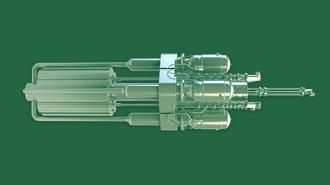This article is an installment of Future Explored, a weekly guide to world-changing technology. You can get stories like this one straight to your inbox every Thursday morning by subscribing here.
One of the best ways to scale up the use of clean nuclear energy in the future might be to scale down the tech, with “microreactors” that can be built and deployed in a fraction of the time required for traditional nuclear power plants. They’re being explored for use everywhere from university campuses to disaster zones and even bases on the moon.
The nuclear option
At nuclear power plants, atoms are split inside reactors. This process — nuclear fission — releases a tremendous amount of energy in the form of heat. That heat is then used to boil water, creating steam that spins electricity-generating turbines.
Unlike the burning of coal or natural gas, nuclear fission doesn’t generate carbon emissions. It’s also more consistent than environmentally dependent sources of energy, such as solar and wind power, while taking up much less physical space than solar or wind farms.
Despite those benefits, only 10% of the world’s electricity is generated by nuclear power plants, and the power source is on the decline, with older plants closing faster than new ones are being built — and size is a major reason for this downturn.
“The biggest barrier to new nuclear construction is mobilising investment.”
International Energy Agency
Matters of size
Most nuclear power plants are massive affairs — in the US, the average facility takes up about a square mile of land and generates 1 gigawatt (GW) of power, which is about enough to power 750,000 homes.
Building such a plant today can cost upwards of $10 billion and take 7 years, and that’s if everything goes according to plan.
In Georgia, a project to add two 1.1 GW reactors to an existing nuclear power plant started construction in 2009 with an estimated cost of $14 billion — the total cost of the project now exceeds $30 billion, and construction still isn’t complete.
Rather than take on such a risky endeavor, clean energy investors are more likely to put their money into solar or wind farms, which are cheaper but require 75 and 360 times as much land, respectively, to generate the same amount of power as the steady 1 GW nuclear reactor.
“The biggest barrier to new nuclear construction is mobilising investment,” wrote the International Energy Agency in a 2019 report.

Microreactors
Rather than hoping investors will take a chance on building large nuclear power plants like the ones we already have, some experts are betting on “microreactors” as the future of nuclear energy.
These in-development reactors are a 100th to 1,000th the size of traditional ones, and while they couldn’t meet the energy needs of a large city, they can be deployed in more places and could potentially power a small remote community, a military base, or even a college campus.
Because microreactors are designed to be built and assembled in factories and then shipped to a site for installation, their upfront cost is expected to be much lower. They can also be deployed quickly, which opens up their potential use in disaster relief.
“Having another option for restoring power quickly following natural disasters would support faster restoration of critical services such as hospitals, communications, and the water supply to the local community,” wrote the US Government Accountability Office in 2020.
Looking ahead
Microreactors are still a new technology, and the US’s Nuclear Regulatory Commission (NRC) has yet to approve a design for commercial use.
The NRC did recently approve its first small modular reactor — those are factory-made reactors larger than microreactors, but still far smaller than traditional designs — and microreactors could be next, as several groups plan to demonstrate their tech within the next five years or so.
Here are a few projects to keep your eye on:
Project Pele: In April 2022, the US Department of Defense announced that it was moving forward with Project Pele, an initiative to design, build, and demonstrate a prototype microreactor at the Idaho National Laboratory (INL).
This reactor will be in the range of 1-5 MW and is being built by nuclear energy company BWX Technologies as part of a $300 million contract. BWXT is expected to deliver the microreactor to the INL in 2024, and the plan is for it to be operational within 72 hours of delivery.
INL will then run the microreactor for at least three years at full capacity. The US already envisions applying what it learns from the prototype to future military efforts, as well as space missions that will require us to provide power to astronauts on the moon.

Westinghouse’s eVinci: Pennsylvania’s Westinghouse Electric Company — a pioneer of nuclear power back in the 1950s, and the same company working on the expensive nuclear power project in Georgia — is developing its own microreactor: the eVinci.
This microreactor is designed to generate up to 5 MW of electricity or 13 MW of heat — essentially, rather than using the heat from fission to boil water, it can be used directly to warm homes and other buildings.
The eVinci is designed to take less than 30 days to install onsite, and while the first units are expected to cost $90 million to $120 million, Westinghouse believes the price could drop to about $60 million as production increases.
The company has already begun submitting documents needed for approval to the NRC. It hopes to have its tech licensed by 2027, and Penn State has already signed a memorandum of understanding with the company to install an eVinci on its main campus.
Radiant’s Kaleidos: In 2020, a team of former SpaceX engineers launched Radiant, a startup focused on the development of a 1.2 MW nuclear microreactor, called “Kaleidos,” that is designed to fit inside a shipping container and be installed overnight.
Radiant envisions Kaleidos replacing the diesel generators used by remote communities. The microreactor could also be installed at hospitals, data centers, and military bases to provide backup power in the event the main source of electricity fails.
Radiant hopes to have a fueled demonstration of the reactor ready by 2026, and while it hasn’t said what Kaleidos will cost, it says it expects it to be cheaper than diesel generators. For now, it will continue developing the system with researchers at the DoE’s Argonne National Laboratory.
“We plan to be the first new commercial reactor design to achieve a fueled test in more than 50 years,” said Radiant CEO Doug Bernauer.
The bottom line
While many microreactor designs are expected to be safer than full-sized plants, they still produce a small amount of radioactive waste that needs to be stored. Many also require high-assay low-enriched uranium, which is easier (although not easy) to make into nuclear weapons than the less enriched fuel used in traditional reactors.
Besides those limitations, it would also take a lot of microreactors to decarbonize the world — but that doesn’t mean the tech couldn’t be a key piece of the clean energy puzzle, along with its larger counterpart, the small modular reactor.
“While the role of large reactors continues to be important to our nation and others around the world, customers needs [sic] product choice and that is precisely what these smaller systems provide,” writes the DoE.
We’d love to hear from you! If you have a comment about this article or if you have a tip for a future Freethink story, please email us at [email protected].






